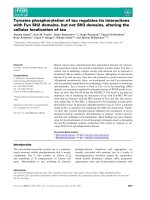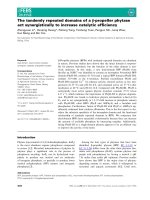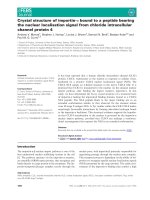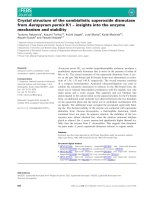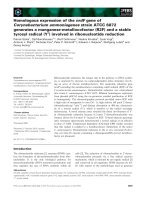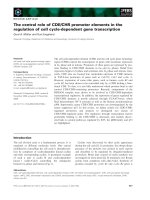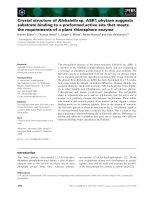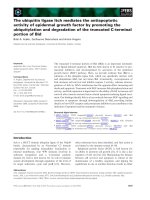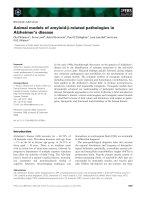Báo cáo khoa học: " The cross-reactivity of the enterovirus 71 to human brain tissue and identification of the cross-reactivity related fragments" ppsx
Bạn đang xem bản rút gọn của tài liệu. Xem và tải ngay bản đầy đủ của tài liệu tại đây (1.64 MB, 10 trang )
RESEARC H Open Access
The cross-reactivity of the enterovirus 71 to
human brain tissue and identification of the
cross-reactivity related fragments
Chun Shi Jia
1
, Jiang Ning Liu
1
, Wan Bo Li
1
, Chun Mei Ma
1
, Shu Zhu Lin
1
, Yi Hao
1
, Xue Zhong Gao
2
, Xiao Lin Liu
2
,
Yan Feng Xu
1
, Lian Feng Zhang
1
, Chuan Qin
1*
Abstract
Background: EV71 occasionally cause a series of severe neurological symptoms, including aseptic meningitis,
encephalitis, and poliomyelitis-like paralysis. However, the neurological destruction mechanism was remained to be
clarified. This study described the cross reaction between EV71 induced IgG and human brain tissue.
Results: Cross reaction of the IgG from 30 EV71 infected patients’ sera to human tissues of cerebra was observed,
which suggested that some EV71 antigens could induce IgG cross-reactivity to human cerebra. To identify the
regions of EV71 virus that containing above antigens, the polypeptide of virus was divided into 19 peptides by
expression in prokaryotes cell. Mouse anti-sera of these peptides was prepared and applied in
immunohistochemical staining with human adult and fetus brain tissue, resp ectively. The result indicated the 19
peptides can be classified into three groups: strong cross-reactivity, weak cross-reactivity and no cross-reactivity
with human brain tiss ue according the cross reaction activity. Then, the increased Blood Brain Barrier (BBB)
permeability and permits IgG entry in neonatal mice after EV71 infection was determined.
Conclusion: EV71 induced IgG could enter BBB and cross-reacted with brain tissue in EV71 infected neonatal mice,
and then the peptides of EV71 that could induce cross-reactivity with brain tissue were identified, which should be
avoided in future vaccine designing.
Background
Human enterovirus (EV71) was first described by Schim-
dit et al. in 1974 [1], which belonging to Picornaviridea
family and has a single positive stranded ribonucl eic acid
(RNA) of about 7,500 nucleot ides [2,3]. Ther e have 13
large and small reported outbreaks of EV71 throughout
the world since then, which main leads to high preva-
lence of hand, foot and mouth disease (HFMD) in infants
and children under 6 years old [4-6]. In past decades,
countries in the Asia-Pacific region have experienced an
increased occurrence of EV71 associated HMFD out-
break [7-11]. Most of EV71 infection are benign and self-
limited in nature , however, EV71 infection has been
reported to cause neurological disease manifesting as
aseptic meningitis, en cephalitis or poliomyelitis-like
acute flaccid paralysis, and neurological originated pul-
monary edema or hemorrhage was the main reason of
lethal symptom [4,12]. The central nervous system (CNS)
injury dependent EV71 neuropathology is supposed as
the main reason kills neuron and then lead to subsequent
neurological destruction [4,13-18]. Although a certain
numbers of research work have b een carried out, as no
abundant virus titer was detected in the CNS during
EV71 challenge in mice model, meanwhile, t he attenu-
ated EV71 strain can still induce weak neurological
symptoms in monkey, the det ailed mechanism of CNS
dysfunction is remained to be clarified [15,19].
EV71 virus infection was reported to increase the per-
meability of BBB [20,21]. However, as enter of virus into
cranial was dependent on a retrograde axonal neuronal
transmission way, the increased permeability in BBB was
presumed not essential for virus through BBB. As
* Correspondence:
1
Key Laboratory of Human Diseases Comparative Medicine, Ministry of
Health, Institute of Laboratory Animal Science, Chinese Academy of Medical
Sciences (CAMS) & Comparative Medicine Centre, Peking Union Medical
Collage (PUMC), Chao Yang Strict, Pan Jia Yuan Nan Li No.5, Beijing 100021,
PR China
Jia et al. Virology Journal 2010, 7:47
/>© 2010 Jia et al; licensee BioMed Central Ltd. This is an Open Access article distributed under the terms of the Creative Commons
Attribution License ( which permits unrestricted use, distribution, and reprod uction in
any medium, provided the original wor k is properly cited.
described in Epilepsy, self immunity caused by the com-
mon antigens between virus and cell receptors lead to
neuron injury, in w hich the central nervous system
(CNS) is attacked by the immune system and that pro-
vide a inspiration for the possible new way during t he
pathology of EV71 infection study [22].
In current study, the sera isolated from EV71 infected
patients were indicated to cross reaction with the
human tissues of cerebrum by immunohistochemical
staining and then the regions can elicit cross-reactivity
with normal brain tissues were identified.
Results
Cross reaction of the IgG from EV71 infected patients’
sera to human tissues of cerebra
A large outbreak of HFMD in infants and children was
happened in Fuyang region of China in the spring of
2008 [23,24]. Thirty sera from children with HFMD was
collected, who was infected with EV71 after RT-PCR
diagnosis the specimen of throat swab, and the presence
of EV71 induced antibody (both IgM and IgG) in all the
thirty sera was verified by ELISA (data not sho w). As
neurological pulmonary edema or hemorrhage was the
main reason of lethal symptom [25,26], and our inacti-
vated virus vaccine showed neurological virulence while
applied in primates test (date not show), the 30 sera from
EV71 infected patients were used as primary anti-sera to
perform the immunohistochemical staining with adult
human tissues of cerebra (Fig. 1). The normal sera from
five donors (four children and one adult) were used as
negative control, in which the anti- EV71 IgG and IgM
was free with ELISA analysis. The human tissues of cere-
bra was not stained obviously with negative control s era
(Fig. 1B-F), while the human tissues of cerebra was
stained on the neuron glial c ell, neuron and stroma by
thepatientssera(Fig.1G-L).Thepositivestainingwas
observed in all of the 30 sera from EV71 infected patients
and 86% of the 30 sera showed cross reaction with 10-
40% stained cells (Table 1). To exclude the interference
of remained ingredients in sera, the IgG fraction in three
sera samples were purified and used as primary antibo-
dies in immunohistochemical staining with human brain
tissues, and the results were consistent to sera’sexperi-
ment in neuron glial cell and neuron, but not in stroma
(Fig. 1M-O). These results indicated the presence of spe-
cific IgG in the EV71 infected patient sera having the
cross-reactivity activity to human cerebra and suggested
that some EV71 antigens could induce cross-reactivity to
human cerebra. The expression and purification of the
peptides disassembled from EV71To identify the regions
of EV71 virus that can induce antibodies binding with
human brain tissue, the genome of EV71 was divided
into 22 regions in sequence, which encode peptides
between 22~156 amino acids (Fig. 2A), and the nearby
fragments in a functional gene have 12 to 39 bp overlap
to avoid the miss of epitope. EV71 of Fuyang-0805 strain
isolated from Anhui province of China was used as the
templates for primers designing and RT-PCR (see Addi-
tional file 1). Targeted cDNA fragments were cloned into
pETISvectormodifiedfrompET28a(+)(Fig.2B),and
then the fusion peptides w ith six histidine residues tag
were over-expressed. Nineteen of the 22 targeted cDNA
fragments were synthesized in insoluble inclusion body
forms by E. coli, but three of them, P
1013-1111
,P
1112-1201
and P
1527-1548
,werefailedtoexpression in this bacteria
strain. After Ni-HTA purification, all of the 19 peptides
were purified to a purity of 95% (see Additional file 2).
Identification of EV71 fragments inducing cross-reactivity
to human brain tissue
The 19 purified peptide s were applied to immunize the 6
weeks female ICR mice according polyclonal antibody pre-
parat ion procedure described in the Method. The sera of
immunized mice were collected, and the titers of IgG
against EV71 in the sera were determined by ELISA
respectively (Table 2). No lesions in any of the brain tis-
sues of immunized mice were observed (data no t show),
then, the 19 sera were applied in immunohistochemical
staining to identify which sera have cross reaction with
human adult and fetus brain tissues, respectively (Fig. 3).
The anti-sera of P
230-323
,P
646-755
,P
857-1012
and P
1329-1440
showed strong staining with neuron plasma in both adult
human cerebra and fetus medulla compared with the
negative control (Fig. 3A-D). The anti-sera of P
1-69
,
P
324-443
,P
444-565
,P
566-665
,P
746-876
,P
1441-1526
,P
1549-1668
,
P
1732-1851
,P
1952-2071
and P
2072-2193
showed weaker staining
with the human brain tissues than the anti-sera of P
230-323
,
P
646-755
,P
857-1012
and P
1329-1440
(Fig. 3E and 3F). The anti-
sera of P
70-159
,P
140-249
,P
1197-1338
,P
1649-1731
,P
1843-1951
did
not show staining with both the adult human cerebra and
fetus medulla sections (Fig. 3G and 3H). This result indi-
cated that the peptides of P
230-323
,P
646-755
,P
857-1012
and
P
1329-1440
could induce strong IgG cross-reactivity to
human brain tissue. The significant of cross reactivity was
not relevant to the specific IgG titer induced by individual
peptides (Table 2), which indicated the cross reactivity was
a specific IgG behavior rather than an antibody dose
dependent artifact.
EV71 infection increased BBB permeability and IgG
transport
An EV71 mice infec tion model was build in our labora-
tory (unpublished data), neonatal mice were intraperito-
neal infect ed with 5 × 10
5
TCID
50
virus within 24 h
after birth, the virus replication was detected in brain,
lung, small intestine and skeletal muscle at 5 dpi by
Real-time P CR and virus titer determination in RD cell,
respectively. Then, the virus locations in these tissues
Jia et al. Virology Journal 2010, 7:47
/>Page 2 of 10
Figure 1 Cross reaction of the IgG from EV71 infected patients’ sera with human tissues of cerebra. The serum was replaced by PBS
buffer as blank control (a), and naive sera from five health donors were used as negative control (b-f). The sera of CNILASTB-16 (g), CNILASTB-19
(h), CNILASTB-1 (i), CNILASTB-2 (j), CNILASTB-4 (k) and CNILASTB-9 (l) were used as primary antibodies in immunohistochemical staining with the
cerebra of adult. The IgG fraction in the sera of NORMAL-1 (m), CNILASTB-12 (n) and CNILASTB-4 (o) were used as primary antibodies in
immunohistochemical staining with the cerebra of adult to exclude the interference of the remained ingredients in sera. The stained glial cell,
stroma and neuron were denoted with black, green and red arrows respectively (×200).
Jia et al. Virology Journal 2010, 7:47
/>Page 3 of 10
were verified by immunohistochemical staining with a
monoclonal antibody of EV71 (Millipore). Large area of
neuron apoptosis was observed in cerebrum and
medulla of brain tissue. In small intestine, intestinal vil-
lus interstitial edema and epithelial cell vacuolar degen-
eration were observed. In skeletal muscle, inflammation,
muscle fiber degeneration and necrosis were scarcely
observed. However, although virus replic ation and virus
antigens were detected in lung, no obvious lesion was
observed in this organ. As no lesions in all the brain tis-
sues of immunized adult mice were observed, we stu-
died the BBB permeability of neonatal mice upon EV71
infection. Naive or EV71 induced IgG was intravenous
injected into the neonatal mice upon EV71 infection or
Table 1 Evaluation the immunohistochemical staining results of patients’ sera to adult human cerebra
Sera no/human
sex/age
Clinical features/Diagnosis Day of sera
collection after
onset
Evaluation
score
NORMAL-1/F/1.5 NO - -
NORMAL-2/M/3.5 NO - -
NORMAL-3/F//4 NO - -
NORMAL-4/M/2.6 NO - -
NORMAL-5/F/23 NO - -
CNILASTB-1/M/1.5 Fever, HMFD/Brain stem encephalitis 1 + + +
CNILASTB-2/F/2.8 Fever, irritability, myoclonus, HFMS/Brain stem encephalitis 1 + +
CNILASTB-3/M/3.6 Fever, myoclonus, HMFD/Brain stem encephalitis 1 + + +
CNILASTB-4/F/4.5 Fever, irritability, HMFD/Brain stem encephalitis 3 ++++
CNILASTB-5/M/2.5 HMFD/- 0 + +
CNILASTB-6/M/1.8 HMFD/- 0 + +
CNILASTB-7/M/1.5 Fever, vomiting, irritability, HMFD/Brain stem encephalitis 0 + + +
CNILASTB-8/F/2.4 HMFD/- 0 + +
CNILASTB-9/F/2.5 Fever, vomiting, motor weakness/Aseptic meningitis 3 ++++
CNILASTB-10/M/1.5 Fever, vomiting, HMFD/Brain stem encephalitis 1 + + +
CNILASTB-11/M/2.2 Fever, irritability, myoclonus, HMFD/Brain stem encephalitis 2 + + +
CNILASTB-12/M/1.6 HMFD/- 0 +
CNILASTB-13/M/1.2 HMFD/- 0 + +
CNILASTB-14/M/1.8 Fever, irritability,/Brain stem encephalitis 0 + +
CNILASTB-15/F/2.6 Fever, lethargy, ataxia, HFMS/Brain stem
encephalitis, neurogenic shock, pulmonary edema
0 ++++
CNILASTB-16/M/4.6 HFMD/- 0 +
CNILASTB-17/M/5.4 HFMD/- 1 + +
CNILASTB-18/F/3.2 Fever, vomiting, lethargy, motor weakness/Aseptic meningitis 1 + + +
CNILASTB-19/F/5.2 HFMD/- 2 +
CNILASTB-20/F/5 Fever, vomiting, lethargy, nystagmus, shock/Brain stem encephalitis, pulmonary edema 1 + + +
CNILASTB-21/M/3.6 Fever, vomiting, headache/Aseptic meningitis 2 ++++
CNILASTB-22/F/3.2 HFMD/- 0 +
CNILASTB-23/F/2.4 Irritability, lethargy, apathy, myoclonus, HFMS/Aseptic meningitis 2 + + +
CNILASTB-24/M/1.7 Fever, vomiting, lethargy, nystagmus, myoclonus, shock/Brain stem encephalitis,
neurogenic shock, pulmonary edema
2 +++
CNILASTB-25/M/3.4 HFMD/- 1 + +
CNILASTB-26/F/4.6 HFMD/- 1 + +
CNILASTB-27/F/2.8 Fever, vomiting, headache, irritability, HMFD/Aseptic meningitis 1 + +
CNILASTB-28/M/3 Fever, lethargy, myoclonus, shock/Aseptic meningitis 2 + + +
CNILASTB-29/F/2 HFMD/- 2 + +
CNILASTB-30/M/3.2 Fever, vomiting, headache, myoclonus, HFMS/Brain stem
encephalitis
1 ++++
- No obvious staining was observed;
+ 0~10% cell was stained;
+ + 11%~20% cell was stained;
+ + + 21%~30% cell was stained;
+ + + + 31%~40% cell was stained.
Jia et al. Virology Journal 2010, 7:47
/>Page 4 of 10
not, respectively. And the detection results were shown
in Fig. 4, both weak staining sites were observed in
EV71 infected mice brain tissues after naive or EV71
induced IgG injection (Fig. 4B and 4D), while the stain-
ing was scarcely observed in normal mice brain tissue
after IgG injection (Fig. 4A and 4C). And the intracra-
nial IgG showed a weak diffused distribution in the
brain tissue of EV71 infected mice, which indicated that
comp ared to normal neonatal mice, the BBB permeabil-
ity of EV71 infected mice was increased and permits
both the naïve IgG and EV71 induced IgG entry.
Discussion
The HFMD occasionally causes a series of severe neuro-
logical symptoms, including aseptic meningitis, encepha-
litis, po liomyelitis-like paralysis and neurologi cal
originated pulmonary edema or hemorrhage [25,27-29],
especia lly the latter was the main reason of lethal symp-
tom in infants and children [4,12]. Previous study sug-
gested the neuropathological symptom was caus ed by
the EV71 infection in CNS [30-34]. However, Chen CS
et al. reported that although the infection led to a per-
sistent viremia and a transient increase in BBB perme-
ability, but only low levels of vir us could be detected in
the mice brain [15], and Arita M et al. reported that the
monkeys vaccinated with an attenuated EV71 showed
the b road range of CNS tissues inflammation related to
the peak stages of IgM and IgG producing, but without
the efficient virus replication [19]. Those results sug-
gested that the pathogenesis of neurological symptoms
with HFMD may have more mechanisms.
We find that all of the tested EV71 infected patients’
sera were presence of IgG to cross-react with health
human brain tissues (Fig. 1), which suggested that a
potenti al cross-reactivity of EV71 with human brain tis-
sues. To identify t he fragments of EV71 that induce
cross-reactivity to human brain tissue, the whole gen-
ome of virus was divided into 22 fragments sequentially.
The 19 of 22 fragments were successfully expressed and
purified, however, 3 fragments was failed to expressed in
prokaryote environment and those were given up. For
cross-reactivity assay, the polyclonal mouse anti-sera
Figure 2 Diagrams of divid ed 22 peptides from EV71 and expression construction. The position and length of 22 peptides divided from
EV71 (a) and expression constructs for 22 peptides (b) were diagramed.
Jia et al. Virology Journal 2010, 7:47
/>Page 5 of 10
against the 19 peptides were prepared and applied in the
immunohistochemical analysis with the adult human
cerebra and fetus medulla. The results indicated the 19
peptides can be divided into three groups according the
cross reaction activity. There were 4 peptides showed
strong cross-reactivity with human brain tissues. There
were 10 peptides showed weak cross-reactivity with
human brain tissues and there were 5 peptides showed
no cross-reactivity with human brain tissues. Sera of
patients and the strong cross-reactivit y peptides showed
a similar pattern on the staining of neuron of the
human brain tissues (Fig. 1 and 3). These suggested the
strong cross-reactivity peptides were potential common
antigens of the EV71 with human brain tissue, however,
the brain bind ing partner of EV71 induce d IgG was not
identified in th is work. The peptide s that elicit antibo -
dies can bind to human brain tissue was dispersed in
whole proteome of EV71, rather than gathered in one or
several structural proteins. So, the potentially self-reac-
tion antibodies would be induced over the whole pro-
cess of virus infection including virus invasion,
propagation and releasing. In previous study, both atte-
nuated and avirulent virus or v irus like particles were
able to induce significant neutralization antibody, relax
the clinical symptoms and reduce mortality rate of
labora tory animals upon lethal virus challenge[19, 35,36].
As indicated in cynomolgus monkeys, although an att e-
nuated EV71 strain showed obvious protection activity
in vivo, the inoculated monkeys still manifested weak
neurological symptom[19]. VP1, located in the surface
of virus particles, was thought as the predominant epi-
tope clustering protein, has been broadly used as subu-
nit vaccine to substitute whole virus and elicit
significant protection on neonatal animals [37-42].
Table 2 ELISA determines the titers of sera from
immunized mice to peptides and virus
OD
450
Value
Peptide name Peptides
a
Virus
b
P
1-69
1.231 ± 0.114 0.231 ± 0.034
P
70-159
1.781 ± 0.221 0.446 ± 0.041
P
140-249
1.940 ± 0.234 0.557 ± 0.071
P
230-323
1.126 ± 0.167 0.359 ± 0.053
P
324-443
1.125 ± 0.138 0.678 ± 0.072
P
444-565
1.864 ± 0.245 1.246 ± 0.116
P
566-665
2.142 ± 0.175 1.648 ± 0.157
P
646-755
0.948 ± 0.056 0.467 ± 0.067
P
746-876
1.084 ± 0.097 0.647 ± 0.064
P
857-1012
1.562 ± 0.149 0.169 ± 0.022
P
1197-1338
2.214 ± 0.195 0.328 ± 0.016
P
1329-1440
1.194 ± 0.134 0.294 ± 0.008
P
1441-1526
1.162 ± 0.158 0.175 ± 0.006
P
1549-1668
0.955 ± 0.037 0.186 ± 0.011
P
1649-1731
1.556 ± 0.115 0.268 ± 0.018
P
1732-1851
1.678 ± 0.160 0.327 ± 0.020
P
1843-1951
1.966 ± 0.138 0.267 ± 0.013
P
1952-2071
1.763 ± 0.129 0.291 ± 0.026
P
2072-2193
1.567 ± 0.146 0.488 ± 0.038
a
the sera were used to determine the titer to its self peptide in a dilution
1:50,000.
b
the sera were used to determine the titer to virus in a dilution 1:1 ,000.
Values represent means ± SD of three independent experiments.
Figure 3 Identification of EV71 fragments inducing cross
immunity to human brain tissue by immunohistochemical
staining. Left panel was adult human cerebra and the right panel
was human fetus medulla. The naive mice sera was used as
negative control (a & b). The serum of immunized mice with
peptide of P
646-755
was one of the four strong cross immunity
peptides(c & d). P
2072-2193
was one of the ten weak cross immunity
peptides (e & f). P
140-249
was one of the five no cross immunity
peptides (g & h). The serum of immunized mice with heat
inactivated virus was used as positive control (i & j). The staining
sites were denoted with arrows (×200).
Jia et al. Virology Journal 2010, 7:47
/>Page 6 of 10
However , the IgG induced by P
646-755
, which belongs to
VP1, elicited strong cross-reactivity to human brain tis-
sue, so the neurological safety of whole virus or VP1
protein as vaccine should be concerned before clinical
application. Many disease and virus infection, especially
the neurological disease can increase the BBB perme-
ability, e.g. stroke, human immunodeficiency virus, Alz-
heimer’ s disease, brain cancer, and bacterial infections
of the CNS [20,21,43], likew ise, the i ncreased BBB per-
meability after EV71 infection was verified in a mice
model [15]. Our result also indicated the increase of
BBB permeability after EV71 infection in infant mice
and further more, the increase of BBB permeability after
EV71 infection could result in the entrance and localiza-
tion of the IgG into brain tissues. Autoimmune disease
was reported in many previous studies, such as celiac
disease, sclerosis, encephalitis, Diabetes mellitus [44-48].
As the BBB in infant can be destructed upon EV71
infection[15] and the EV71 can induce cross-reactivity
IgG, therefore, whether the intracranial entry of EV71
elicited IgG is one o f the mechanisms of neurological
pathogeneses in HFMD patients was remained to be
clarified in further study. However, the cross reaction
fragments of the viruses should be concerned in future
vaccine designing.
Conclusion
In conclusion, this study initially showed the cross-reac-
tivity between EV71 induced IgG and human brain tis-
sue, and the peptides of EV71 that can bring IgG based
cross reaction was identified. We observed the increase
of BBB permeability in neonatal mice under EV71 infec-
tion and the entry of b rain cross reactivity IgG, which
was supposed play a role in subsequent clinical
symptoms.
Material and methods
Cell and virus
RD cells (human rhabdomyosarcoma) were maintained
in Dulbecco’s modified Eagle’s medium with 10% fetal
bovine serum [49]. EV71 FuYang stock virus strain
(Fuyang-0805), which belongs to C4, the predominant
Figure 4 Detection the intracranial IgG in mice after intravenous injection. The normal neonatal mice injected with naive IgG . (a), EV71
infected neonatal mice injected with mice naïve IgG. (b), normal neonatal mice injected with EV71 induced IgG. (c) and EV71 infected neonatal
mice injected with EV71 induced IgG.(d) were compared by the immunohistochemical test. The staining sites were denoted with arrows (× 200).
Jia et al. Virology Journal 2010, 7:47
/>Page 7 of 10
genotype in recent outbreaks in Asia (GenBank acces-
sion number EU703812) was grown in RD cells as
described by He YQ et al. and Lin JY et al [50,51].
The infected cell culture was disrupted by three
freeze-thaw cycles, then the cell debris was removed b y
centrifuged at 3,000 g for 20 min, the virus was col-
lected by centrifuged at 80,000 × g for 3 h, and then
was ected was pur normal neuron resuspended in pho s-
phate b uffered saline (PBS) [36] to prepare the working
stocks containing 10
8
TCID
50
/ml [13].
Clone of the EV71 DNA fragments and construction of
the expression constructs
The EV71 genomic RNA was extracted from the culture
fluid of infected cells using a High-pure viral RNA puri-
fication kit (Qiagen). Reverse tr anscription-PCR (RT-
PCR) was performed using a ReverTra-Plus kit (Invitro-
gen) to clone the full length cDNA [19]. The EV71
cDNA was used as template for peptide coding regions
amplification. The primers and associated restriction
enzyme sites were subjected in Additional file 1. The
cloned fragments were inserted into cloning sites of
pETIS vector under the T7 promoter and His tag was
added a t the N-terminal of the target peptide to form a
fusion peptide with His tag. The expression plasmids
were verified by sequencing analysis respectively.
Peptide expression and purification
Escherichia. coli BL21 (DE3) was transformed by the
constructed expressio n plasmids for protein expression.
The DE3 bacteria strain was cultured with Luria-Bertani
(LB) medium with 50 μg/ml kanamycin at 37°C, 200
rpm. After the OD
600
ofcultureupto0.6,theIPTG
was added to a final concentration of 0.5 mM into the
medium and cultured for 8 h at 25. The bacteria pellet
was harvested by centrifugation at 4, 000 × g for 20
min, and the expression of targeted proteins were
detected by SDS-PAGE.
Protein purification was performed according to the
protocol of Novagen with Ni-HTA resin. Briefly, the
bacteria pellet was resuspended in buf fer B (8 M urine,
0.1 M sodium phosphate salt, 0.01 M Tris-HCl, pH =
8.0) and incubated at 37°C for 30 min, the cell debris
was removed by centrifuged at 20,000 × g for 20 min.
Then the supernatant was loaded onto a Ni-HTA resin
column. The column was washed with 10 fold column
volumes of washing buffer C (8 M urine, 0 .1M sodium
phosphate salt, 0.01 M Tris-HCl, pH = 6.3). The target
protein was then eluted with buffer D (8 M urine, 0.1 M
sodium phosphate salt, 0.01 M Tris-HCl, pH = 4.5) and
dialyzed against 0.9% NaCl, and then the purity of pep-
tides were detected by SDS-PAGE. The concentration of
protein was measured by Bradford method [52].
Immunity
ICRmicewereprovidedbytheInstituteofLaboratory
Animal Science, Peking Union Medical College. All the
mice were bred in an AAALAC-accredited facility and
the use of animals was approved by the Animal Care
and Use Committee of the Institute of Laboratory Ani-
mal Science of Peking Union Medical College
(GC09012). The adult mice were used for polyc lonal
antibody preparation. The peptides were disso lved as
1.0mg/ml of each peptide in 0.9% NaCl and then formu-
latedwithsamevolumeofFreundcompleteadjuvant
(Sigma) according to the manufacturer’sinstructions.
The injected dose of the peptides was 100 μl/mouse
given through intraperitoneal injection (i.p.). The heat
inactivated EV71 were dissolved as 1.0 × 10
9
TCID
50
/ml
in 0.9% NaCl and the injected dose of the virus was 100
μl per mouse. One week after the first injection, the ani-
mals were boosted at the same dose of peptides or the
heat inactivated virus formulatedwithsamevolumeof
Freund incomplete adjuvant (Sigma) through intraperi-
toneal injection(i.p.) and the mice were reboosted
weekly for 2 times.
ELISA
The levels of specific IgG against EV71 or peptides from
the immunized mice or EV71 infected patients were
determined by enzyme-linked immunosorbent assay
(ELISA). Briefly, microtiter plates were coated with 100
μl of heat inactivated virus (1.0 × 10
8
TCID
50
)orpep-
tides (10 μg/ml) in carbonate coating buffer (15 mM
Na
2
CO
3
,35mMNaHCO
3
, pH 9.6). The plates were
incubated at 4°C overnight and then incubated with 1%
BSA in PBS for 2 h at room temperature to prevent
non-specific binding, serial dilutions o f test sera were
added to each well and incubated for 1 h at 37°C, fol-
lowed by horseradish peroxidase (HRP) conjugated goat
anti-mouse IgG (1:5, 000 dilution, Sigma). The reaction
was developed by 100 μl TMB substrate (3, 3’,5,5’-etra-
methylbenzidine), and then terminated by 100 μl2M
H
2
SO
4
. The optical densities at 450 nm were deter-
mined [38].
Immunohistochemical staining
The cerebra and medulla of human brain tissues were
from an adult and a fetus, who were both died in acci-
dents respectively. The usage of human brain tissues
and sera were permitted by Institutional Review Board
(IRB) of FuYang people’s hospital, where these samples
were provided. For immunohistochemical staining, brain
sections were deparaffinized with xylene, rehydrated in
ethanol, and then treated with 0.25% trypsin solution
with 0.5% CaCl
2
in PBS for 30 min and incubated in 1%
hydrogen peroxide in methanol to block endo genous
Jia et al. Virology Journal 2010, 7:47
/>Page 8 of 10
peroxidase activity followed by incubation with 10%
Block Ace (Sigma) in PBS. The treated sections were
incubated with specific serum (1:200 dilution for
patients’ sera and 1:1000 dilution for mice sera with
0.05% Triton ×-100-PBS) or puri fied IgG fraction (1 μg/
ml) from sera of EV71 infected patients at 4°C over-
night. The sections were washed three times with PBS
and then incubated with HRP-conjugated goat anti-
human IgG (for patients’ sera, 1:500 dilution, Sigma) or
HRP-conjugated goat anti-mouse IgG (for innunized
mice sera, 1:1000 dilution, Sigma) for 1 h at 37°C. The
sections were developed with 3-3’ diaminobenzidine
(DAB) and examined with a light microscope [53].
Intracranial IgG detection
IgG fraction of se ra from EV71 infected patients or
immunized mice were purified by Protein A conjugated
agarose affinity adso rption column [54]. The mice serum
was diluted in 5 volumes loading buffer: 20 mM PBS sal-
ine buffer (pH, 7.0) and loaded on a Protein A agarose
affinity adsorption column. T hen, after washing by 10
volumes loading buffer, the targeted IgG wa s eluted by
0.1 M citric acid (pH, 3.0) and dialysis against PBS buffer
overnightat4°C.10μg IgG were intravenous inje cted
into neonatal mice in 2 days later after EV71 infection,
and the mice were sacrificed with barbital anaesthesia in
1 days later, then the brain tissue sections were prepared
to detect intracranial IgG [20]. IgG presence in brain sec-
tions were detected by immunohistochemical staining
with HRP conjugated goat anti mouse secondary Ab
(1:5,000, sigma) and de veloped with 3-3’diaminobenzi-
dine (DAB) and examined with a light microscope.
Additional file 1: SDS-PAGE detects the purified peptides of EV71.
The SDS-PAGE result of peptides P
1-69
to P
2072-2193
was shown. The
expression plasmids free E. coli BL21 (DE3) strain was manipulated as the
protocol of protein expression and purification of peptides and used as
negative control. The purified peptides were detected by 12% SDS-PAGE
and the purified virus was detected by 8% SDS-PAGE.
Click here for file
[ />S1.DOC ]
Additional file 2: Primers used in divided polypeptides encoding
regions amplification.
Click here for file
[ />S2.DOC ]
Acknowledgements
This work was supported by national sciences and technology major project
(2009ZX10004-402).
Author details
1
Key Laboratory of Human Diseases Comparative Medicine, Ministry of
Health, Institute of Laboratory Animal Science, Chinese Academy of Medical
Sciences (CAMS) & Comparative Medicine Centre, Peking Union Medical
Collage (PUMC), Chao Yang Strict, Pan Jia Yuan Nan Li No.5, Beijing 100021,
PR China.
2
Fuyang People’s Hospital, Lu Ci Street No.63, Fu Yang city, An Hui
province 236003, PR China.
Authors’ contributions
JCS and LJN conducted all experiments except for the
Immunohistochemical staining and draft the manuscript. MCM, HY and XYF
performed Immunohistochemical staining. LSZ, GXZ and LXL collected the
EV71 infected patients sera. LWB and ZLF designed the experiment and
edited the manuscript. QC provided overall supervision, financial support
and prepared the final version of the manuscript. All authors read and
approved the final manuscript.
Competing interests
The authors declare that they have no competing interests.
Received: 23 October 2009
Accepted: 22 February 2010 Published: 22 February 2010
References
1. Schmidt NJ, Lennette EH, Ho HH: An apparently new enterovirus isolated
from patients with disease of the central nervous system. J Infect Dis
1974, 129:304-309.
2. Brown BA, Pallansch MA: Complete nucleotide sequence of enterovirus
71 is distinct from poliovirus. Virus Res 1995, 39:195-205.
3. Brown BA, Oberste MS, Alexander JP Jr, Kennett ML, Pallansch MA:
Molecular epidemiology and evolution of enterovirus 71 strains isolated
from 1970 to 1998. J Virol 1999, 73:9969-9975.
4. Ortner B, Huang CW, Schmid D, Mutz I, Wewalka G, Allerberger F, Yang JY,
Huemer HP: Epidemiology of enterovirus types causing neurological
disease in Austria 1999-2007: detection of clusters of echovirus 30 and
enterovirus 71 and analysis of prevalent genotypes. J Med Virol 2009,
81:317-324.
5. Fowlkes AL, Honarmand S, Glaser C, Yagi S, Schnurr D, Oberste MS,
Anderson L, Pallansch MA, Khetsuriani N: Enterovirus-associated
encephalitis in the California encephalitis project, 1998-2005. J Infect Dis
2008, 198:1685-1691.
6. Diedrich S, Weinbrecht A, Schreier E: Seroprevalence and molecular
epidemiology of enterovirus 71 in Germany. Arch Virol 2009,
154:1139-1142.
7. Mizuta K, Abiko C, Murata T, Matsuzaki Y, Itagaki T, Sanjoh K, Sakamoto M,
Hongo S, Murayama S, Hayasaka K: Frequent importation of enterovirus
71 from surrounding countries into the local community of Yamagata,
Japan, between 1998 and 2003. J Clin Microbiol 2005, 43:6171-6175.
8. Gau SS, Chang LY, Huang LM, Fan TY, Wu YY, Lin TY: Attention-deficit/
hyperactivity-related symptoms among children with enterovirus 71
infection of the central nervous system. Pediatrics 2008, 122:e452-458.
9. Lin YW, Wang SW, Tung YY, Chen SH: Enterovirus 71 Infection of Human
Dendritic Cells. Exp Biol Med (Maywood) 2009.
10. Zhu JP, Xu ZG, Chen H, Zhang X, Fan DY, Wang J: Primary detection of
pathogen from children with hand, foot, and mouth disease in Beijing,
2007. Bing Du Xue Bao 2009, 25:23-28.
11. Ding NZ, Wang XM, Sun SW, Song Q, Li SN, He CQ: Appearance of mosaic
enterovirus 71 in the 2008 outbreak of China. Virus Res 2009.
12. Lin YW, Chang KC, Kao CM, Chang SP, Tung YY, Chen SH: Lymphocyte and
antibody responses reduce enterovirus 71 lethality in mice by
decreasing tissue viral loads. J Virol 2009, 83:6477-6483.
13. Wang YF, Chou CT, Lei HY, Liu CC, Wang SM, Yan JJ, Su IJ, Wang JR,
Yeh TM, Chen SH, Yu CK: A mouse-adapted enterovirus 71 strain causes
neurological disease in mice after oral infection. J Virol 2004,
78:7916-7924.
14. Nishimura Y, Shimojima M, Tano Y, Miyamura T, Wakita T, Shimizu H:
Human P-selectin glycoprotein ligand-1 is a functional receptor for
enterovirus 71. Nat Med 2009, 15:794-797.
15. Chen CS, Yao YC, Lin SC, Lee YP, Wang YF, Wang JR, Liu CC, Lei HY, Yu CK:
Retrograde axonal transport: a major transmission route of enterovirus
71 in mice. J Virol
2007, 81:8996-9003.
16. Chen YC, Yu CK, Wang YF, Liu CC, Su IJ, Lei HY: A murine oral enterovirus
71 infection model with central nervous system involvement. J Gen Virol
2004, 85:69-77.
17. Nagata N, Iwasaki T, Ami Y, Tano Y, Harashima A, Suzaki Y, Sato Y,
Hasegawa H, Sata T, Miyamura T, Shimizu H: Differential localization of
Jia et al. Virology Journal 2010, 7:47
/>Page 9 of 10
neurons susceptible to enterovirus 71 and poliovirus type 1 in the
central nervous system of cynomolgus monkeys after intravenous
inoculation. J Gen Virol 2004, 85:2981-2989.
18. Nagata N, Shimizu H, Ami Y, Tano Y, Harashima A, Suzaki Y, Sato Y,
Miyamura T, Sata T, Iwasaki T: Pyramidal and extrapyramidal involvement
in experimental infection of cynomolgus monkeys with enterovirus 71. J
Med Virol 2002, 67:207-216.
19. Arita M, Nagata N, Iwata N, Ami Y, Suzaki Y, Mizuta K, Iwasaki T, Sata T,
Wakita T, Shimizu H: An attenuated strain of enterovirus 71 belonging to
genotype a showed a broad spectrum of antigenicity with attenuated
neurovirulence in cynomolgus monkeys. J Virol 2007, 81:9386-9395.
20. Wang H, Sun J, Goldstein H: Human immunodeficiency virus type 1
infection increases the in vivo capacity of peripheral monocytes to cross
the blood-brain barrier into the brain and the in vivo sensitivity of the
blood-brain barrier to disruption by lipopolysaccharide. J Virol 2008,
82:7591-7600.
21. Bowman GL, Kaye JA, Moore M, Waichunas D, Carlson NE, Quinn JF: Blood-
brain barrier impairment in Alzheimer disease: stability and functional
significance. Neurology 2007, 68:1809-1814.
22. Ganor Y, Goldberg-Stern H, Amrom D, Lerman-Sagie T, Teichberg VI,
Pelled D, Futerman AH, Zeev BB, Freilinger M, Verheulpen D, et al:
Autoimmune epilepsy: some epilepsy patients harbor autoantibodies to
glutamate receptors and dsDNA on both sides of the blood-brain
barrier, which may kill neurons and decrease in brain fluids after
hemispherotomy. Clin Dev Immunol 2004, 11:241-252.
23. Wu Z, Yang F, Zhao R, Zhao L, Guo D, Jin Q: Identification of small
interfering RNAs which inhibit the replication of several Enterovirus 71
strains in China. J Virol Methods 2009, 159:233-238.
24. Yang Y, Wang H, Du J, Zhao XS, Gong EC, Gao ZF, Zheng J: Molecular
confirmation of enterovirus type 71 infection: a post-mortem study of
two cases. Zhonghua Bing Li Xue Za Zhi 2009, 38:258-262.
25. Chang LY, Lin TY, Hsu KH, Huang YC, Lin KL, Hsueh C, Shih SR, Ning HC,
Hwang MS, Wang HS, Lee CY: Clinical features and risk factors of
pulmonary oedema after enterovirus-71-related hand, foot, and mouth
disease. Lancet 1999, 354:1682-1686.
26. Fujimoto T, Chikahira M, Yoshida S, Ebira H, Hasegawa A, Totsuka A,
Nishio O: Outbreak of central nervous system disease associated with
hand, foot, and mouth disease in Japan during the summer of 2000:
detection and molecular epidemiology of enterovirus 71. Microbiol
Immunol 2002, 46:621-627.
27. Ang LW, Koh BK, Chan KP, Chua LT, James L, Goh KT: Epidemiology and
control of hand, foot and mouth disease in Singapore, 2001-2007. Ann
Acad Med Singapore 2009, 38:106-112.
28. Chang LY, Hsia SH, Wu CT, Huang YC, Lin KL, Fang TY, Lin TY: Outcome of
enterovirus 71 infections with or without stage-based management:
1998 to 2002. Pediatr Infect Dis J 2004, 23:327-332.
29. Chang LY, Lee CY, Kao CL, Fang TY, Lu CY, Lee PI, Huang LM: Hand, foot
and mouth disease complicated with central nervous system
involvement in Taiwan in 1980-1981. J Formos Med Assoc 2007,
106:173-176.
30. Chang LY, Huang LM, Gau SS, Wu YY, Hsia SH, Fan TY, Lin KL, Huang YC,
Lu CY, Lin TY: Neurodevelopment and cognition in children after
enterovirus 71 infection. N Engl J Med 2007, 356:1226-1234.
31. Chen CY, Chang YC, Huang CC, Lui CC, Lee KW, Huang SC: Acute flaccid
paralysis in infants and young children with enterovirus 71 infection: MR
imaging findings and clinical correlates. AJNR Am J Neuroradiol 2001,
22:200-205.
32. Huang CC: Neurologic complications of enterovirus 71 infection in
children: lessons from this Taiwan epidemic. Acta Paediatr Taiwan 2001,
42:5-7.
33. Tyler KL: Emerging viral infections of the central nervous system: part 1.
Arch Neurol 2009, 66:939-948.
34. Wong KT, Munisamy B, Ong KC, Kojima H, Noriyo N, Chua KB, Ong BB,
Nagashima K: The distribution of inflammation and virus in human
enterovirus 71 encephalomyelitis suggests possible viral spread by
neural pathways. J Neuropathol Exp Neurol 2008, 67:162-169.
35. Wu TC, Wang YF, Lee YP, Wang JR, Liu CC, Wang SM, Lei HY, Su IJ, Yu CK:
Immunity to avirulent enterovirus 71 and coxsackie A16 virus protects
against enterovirus 71 infection in mice. J Virol 2007, 81:10310-10315.
36. Chung YC, Ho MS, Wu JC, Chen WJ, Huang JH, Chou ST, Hu YC:
Immunization with virus-like particles of enterovirus 71 elicits potent
immune responses and protects mice against lethal challenge. Vaccine
2008, 26:1855-1862.
37. Zhou BP, Liu WL, Xie JJ, Chen XC, Xu LM, Tan Y, Liu YX, Yang GL:
Expression of recombinant VP1 protein of enterovirus 71 and
development of serological assay for detection of EV71 infection.
Zhonghua Shi Yan He Lin Chuang Bing Du Xue Za Zhi 2008, 22:492-494.
38. Chen HL, Huang JY, Chu TW, Tsai TC, Hung CM, Lin CC, Liu FC, Wang LC,
Chen YJ, Lin MF, Chen CM: Expression of VP1 protein in the milk of
transgenic mice: a potential oral vaccine protects against enterovirus 71
infection. Vaccine 2008, 26:2882-2889.
39. Foo DG, Ang RX, Alonso S, Chow VT, Quak SH, Poh CL: Identification of
immunodominant VP1 linear epitope of enterovirus 71 (EV71) using
synthetic peptides for detecting human anti-EV71 IgG antibodies in
Western blots. Clin Microbiol Infect 2008, 14:286-288.
40. Sivasamugham LA, Cardosa MJ, Tan WS, Yusoff K: Recombinant Newcastle
Disease virus capsids displaying enterovirus 71 VP1 fragment induce a
strong immune response in rabbits. J Med Virol 2006, 78:1096-1104.
41. Chiu CH, Chu C, He CC, Lin TY: Protection of neonatal mice from lethal
enterovirus 71 infection by maternal immunization with attenuated
Salmonella enterica serovar Typhimurium expressing VP1 of enterovirus
71. Microbes Infect 2006, 8:1671-1678.
42. Chen HF, Chang MH, Chiang BL, Jeng ST: Oral immunization of mice
using transgenic tomato fruit expressing VP1 protein from enterovirus
71. Vaccine 2006, 24:2944-2951.
43. Olsen AL, Morrey JD, Smee DF, Sidwell RW: Correlation between
breakdown of the blood-brain barrier and disease outcome of viral
encephalitis in mice. Antiviral Res 2007, 75:104-112.
44. Zanoni G, Navone R, Lunardi C, Tridente G, Bason C, Sivori S, Beri R,
Dolcino M, Valletta E, Corrocher R, Puccetti A: In celiac disease, a subset of
autoantibodies against transglutaminase binds toll-like receptor 4 and
induces activation of monocytes. PLoS Med 2006, 3:e358.
45. Bataller L, Kleopa KA, Wu GF, Rossi JE, Rosenfeld MR, Dalmau J:
Autoimmune limbic encephalitis in 39 patients: immunophenotypes and
outcomes. J Neurol Neurosurg Psychiatry 2007, 78:381-385.
46. Grigoriadis N, Hadjigeorgiou GM: Virus-mediated autoimmunity in
Multiple Sclerosis. J Autoimmune Dis 2006, 3:1.
47. Sloka S: Observations on recent studies showing increased co-
occurrence of autoimmune diseases. J Autoimmun 2002, 18:251-257.
48. Seissler J, de Sonnaville JJ, Morgenthaler NG, Steinbrenner H, Glawe D,
Khoo-Morgenthaler UY, Lan MS, Notkins AL, Heine RJ, Scherbaum WA:
Immunological heterogeneity in type I diabetes: presence of distinct
autoantibody patterns in patients with acute onset and slowly
progressive disease. Diabetologia 1998, 41:891-897.
49. Lin YC, Wu CN, Shih SR, Ho MS: Characterization of a Vero cell-adapted
virulent strain of enterovirus 71 suitable for use as a vaccine candidate.
Vaccine 2002, 20:2485-2493.
50. Lin JY, Shih SR, Pan M, Li C, Lue CF, Stollar V, Li ML: hnRNP A1 interacts
with the 5’ untranslated regions of enterovirus 71 and Sindbis virus RNA
and is required for viral replication. J Virol 2009, 83:6106-6114.
51. He YQ, Yang H, Li LL, Tan J, Zhou L, Mao LS, Yang F, Liu JJ, Lv X: Genotype
analysis of enterovirus type 71 detected from patients with hand-foot-
mouth disease in Shenzhen. Zhonghua Liu Xing Bing Xue Za Zhi 2008,
29:790-793.
52. Bradford MM: A rapid and sensitive method for the quantitation of
microgram quantities of protein utilizing the principle of protein-dye
binding. Anal Biochem 1976, 72:248-254.
53. Arita M, Ami Y, Wakita T, Shimizu H: Cooperative effect of the attenuation
determinants derived from poliovirus sabin 1 strain is essential for
attenuation of enterovirus 71 in the NOD/SCID mouse infection model. J
Virol 2008, 82:1787-1797.
54. Ito W, Kurosawa Y: Development of an artificial antibody system with
multiple valency using an Fv fragment fused to a fragment of protein A.
J Biol Chem 1993, 268:20668-20675.
doi:10.1186/1743-422X-7-47
Cite this article as: Jia et al.: The cross-reactivity of the enterovirus 71 to
human brain tissue and identification of the cross-reactivity related
fragments. Virology Journal 2010 7:47.
Jia et al. Virology Journal 2010, 7:47
/>Page 10 of 10
